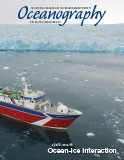Article Abstract
Assessments of the Antarctic contribution to future sea level rise have generally focused on ice loss in West Antarctica. This focus was motivated by glaciological and oceanographic observations that showed ocean warming was driving loss of ice mass from the West Antarctic Ice Sheet (WAIS). Paleoclimate studies confirmed that ice discharge from West Antarctica contributed several meters to sea level during past warm periods. On the other hand, the much larger East Antarctic Ice Sheet (EAIS) was generally considered to be relatively stable because of being largely grounded above sea level and therefore protected from ocean heat flux. However, recent studies suggest that a large part of the EAIS is grounded well below sea level and that the EAIS also retreated and contributed several meters to sea level rise during past warm periods. We use ocean observations from three ice shelf systems to illustrate the variety of ocean-ice shelf interactions taking place in East Antarctica and to discuss the potential vulnerability of East Antarctic ice shelves to ocean heat flux. The Amery and the Mertz are “cold cavity” ice shelves that exhibit relatively low area-averaged basal melt rates, although substantial melting and refreezing occurs beneath the large and deep Amery Ice Shelf. In contrast, new oceanographic measurements near the Totten Ice Shelf show that warm water enters the sub-ice-shelf cavity and drives rapid basal melting, as is seen in West Antarctica. Totten Glacier is of particular interest because it holds a marine-based ice volume equivalent to at least 3.5 m of global sea level rise, an amount comparable to the entire marine-based WAIS, and recent glaciological measurements show the grounded portion of Totten Glacier is thinning and the grounding line is retreating. Multiple lines of evidence support the hypothesis that parts of the EAIS are more dynamic than once thought. Given that the EAIS contains a volume of marine-based ice equivalent to 19 m of global sea level rise, the potential for ocean-driven melt to destabilize the marine-based ice sheet needs to be accounted for in assessments of future sea level rise.

